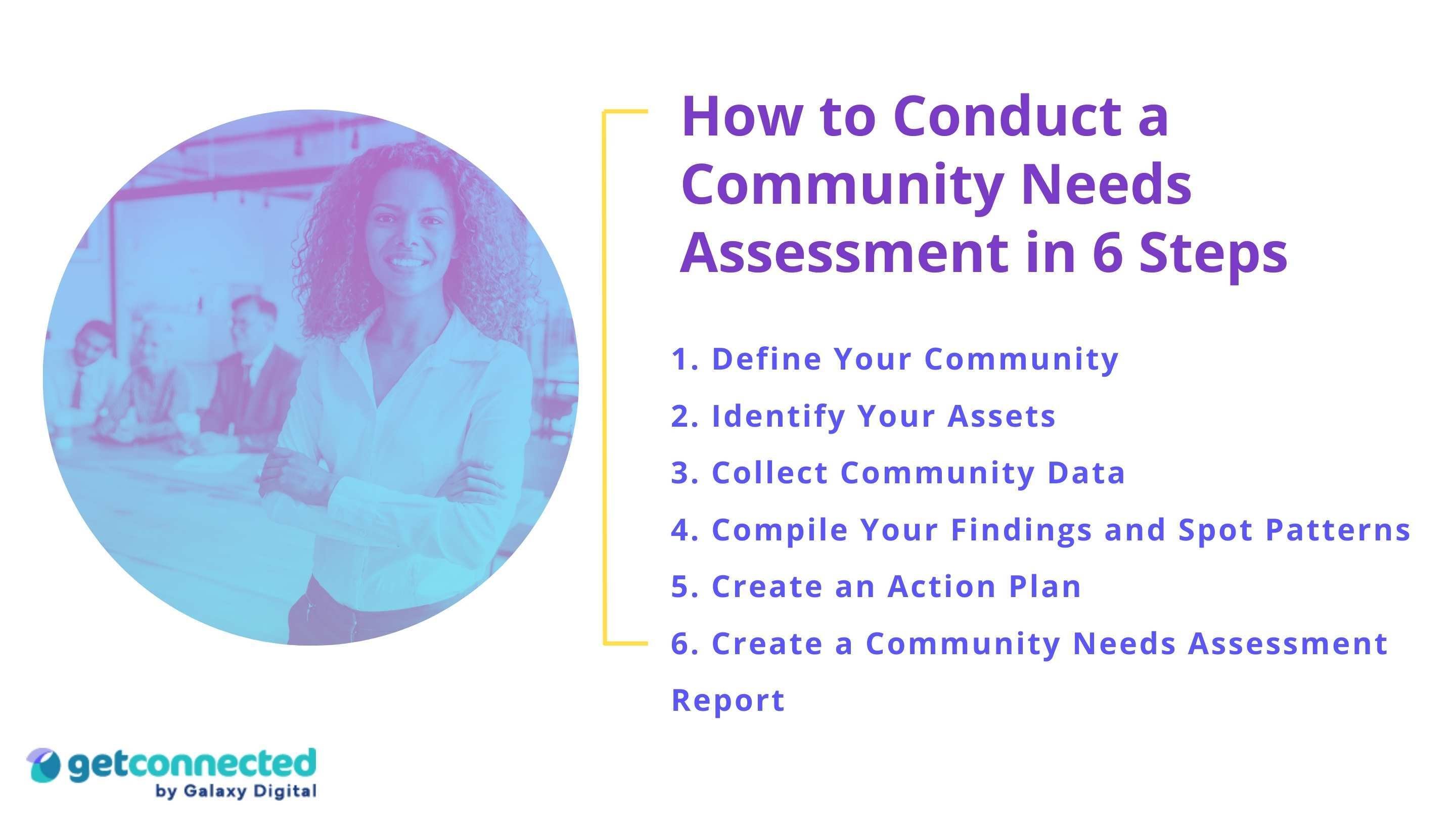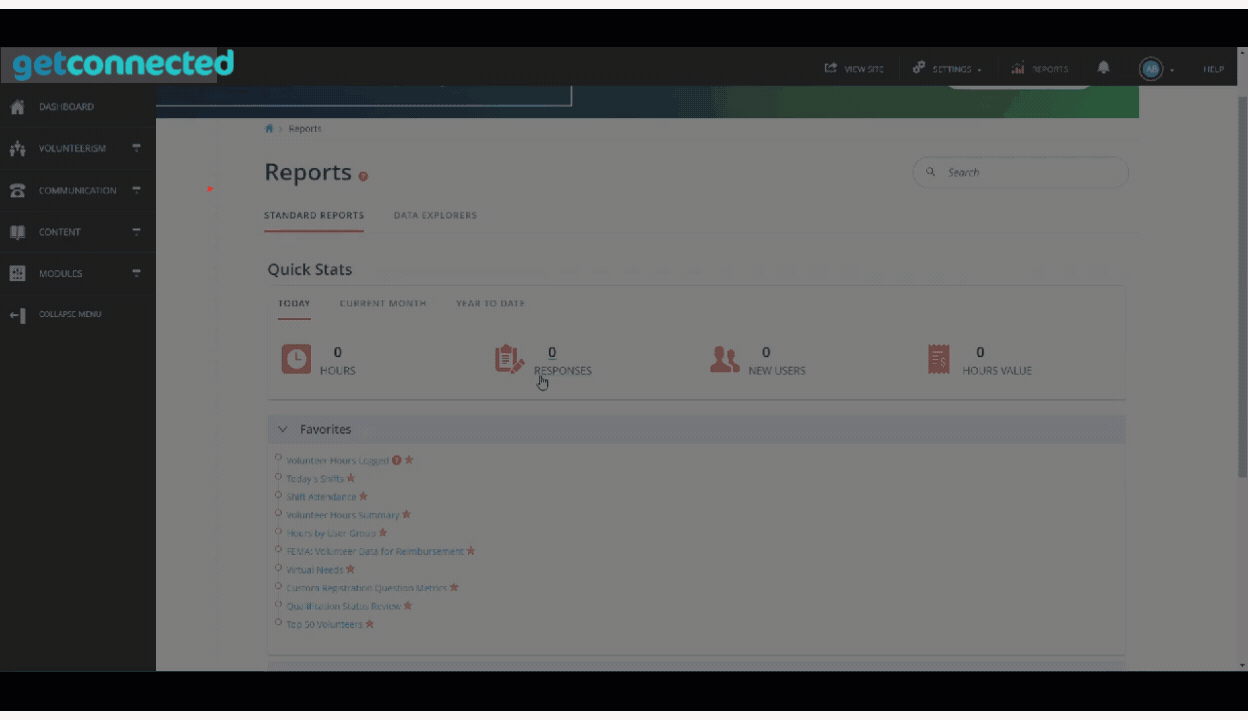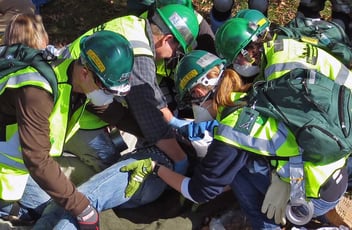Free Community Needs Assessment Kit - Checklist, report outline, assessment & action plan
Whether you’re developing a new volunteer program or reviewing an existing project, it’s important to know what your community actually needs and the resources available to you. That’s where a community needs assessment comes in.
In this article, we’ll dive into how to conduct a community needs assessment and best practices for building your program around this assessment. Plus, we’ll share valuable resources, including examples and a free template.
Key takeaways
- Define your community first: The community needs assessment process starts by identifying the demographic makeup, attitudes, values, and geographic characteristics of the population you serve.
- Identify both needs and assets: A comprehensive community needs assessment uncovers service gaps while also revealing underutilized resources like volunteer leaders, partner organizations, physical spaces, and existing programs that can amplify your impact.
- Collect diverse data sources: Combine quantitative data (census surveys, public health statistics) with qualitative insights (listening sessions, focus groups, participatory observation) to understand both what community members need and why those needs exist.
- Categorize findings into actionable themes: Organize your assessment results into strengths, challenges, needs, and opportunities—then determine whether each finding requires policy changes, system-level shifts, or direct service modifications.
- Document findings in a formal community needs assessment report: Include key sections like methodology, participation demographics, data analysis, strengths and limitations, and actionable recommendations to communicate results to stakeholders, justify funding requests, and inform new program development.
Article Contents
What is a Community Needs Assessment?
A community needs assessment is a way of collecting data and surveying stakeholders to understand gaps in community services, as well as the strengths and assets available in your community.
Collecting community needs data will help your organization gain a deeper understanding of your community, prioritize its resources, appeal to stakeholders like your board or donors, inform new programming, and celebrate successes.
What are Community Needs?
Anybody working in a service-driven organization knows that communities can experience all types of needs, even at the same time!
However, categorizing your community’s needs will help you understand those that are most pressing and important to your community:
|
Need Type |
Definition |
Community need example |
|
Perceived Needs |
Gaps in services based on what individuals feel about their own needs or the needs of the community. Organizations can learn about perceived needs by speaking directly to community members through surveys, focus groups, or town meetings. |
Community members express concerns about lack of mental health services in their area through a town hall meeting. |
|
Expressed Needs |
A perceived need becomes an expressed need when a number of individuals take similar action. Be mindful of the false assumption that all people with needs always seek help. |
A number of community families are seeking affordable local daycare services because the current services are at capacity. |
|
Normative Needs |
Needs identified based on a set of agreed-upon criteria or standards. |
A state-wide authority establishes standards for public housing; a community identifies a need for improved local public housing based on these criteria. |
|
Absolute Needs |
Universal needs deemed essential for survival. Many organizations and community leaders prioritize absolute needs over others. |
Shelter, food, water, safety, and clothing. |
|
Relative Needs |
Needs identified based on equity—when two groups or communities with similar characteristics do not receive similar services. |
Students from School A who receive free lunches reported being happier at school. The program determines that School B should also receive free lunches to improve student engagement and performance. |
What are the Benefits of a Community Needs Assessment?
A community needs assessment can help your organization:
- Understand your community more deeply: A community needs assessment will help you learn about the culture, social structure, gaps, and strengths of your community so that you can better serve its citizens.
- Prioritize programs and resources: The assessment can reveal both a community’s most pressing needs and leverageable resources so that organizations can direct funding and resources to increase return on investment.
- Get stakeholders on board: Nonprofit organizations must often make the case for their programs to garner support. A community needs assessment report signals that their services and decisions are well-informed and necessary.
- Inform new programs: Identifying community needs and assets will help you develop impactful initiatives, like your next volunteer program.
- Celebrate success: Reporting on the state of services in a community regularly can also help you celebrate the successes of your initiatives.
When Should You Conduct a Community Needs Assessment?
Surveying community members and identifying needs are beneficial at any stage. Here are some of the times you may want to assess community needs:
- When planning and developing a new program or initiative
- During your annual or periodic review of existing projects
- When given a mandate from a local government
- To justify grants, funding, and resource allocation
- To empower communities by identifying their strengths and assets
Want this community needs assessment checklist delivered to your inbox?
Who Should Be Involved in the Needs Assessment?
Here are just some of the voices you can involve in your assessment:
- Community members: These are the folks who will benefit most from the actions you take based on your needs assessment. Whether they’re residents of a neighborhood, an underserved population, or passionate caretakers of your youngest community members, they need to be at the table to address their needs in earnest.
- Your organization’s staff, board members, and supporters: Your entire team, including the board, colleagues, volunteer managers, volunteers, and donors must be aware of your assessment. You’ll not only need their support, but also an array of voices and expertise.
- Social workers and human service providers: These folks have a deep understanding and empathy for affected community members. They are willing to advocate on behalf of clients and feel connected to specific causes that support community improvement.
- Government officials: Elected officials have significant influence and the ability to enact life-changing policies. Involving them in the process can increase buy-in from key players.
- Influential people: Involve directors, CEOs, presidents, and other people of professional or social influence, especially if they're widely known for their positive contributions to the community.
- Subject matter experts: In some cases, you may need to involve experts in a particular field. Let’s say your program provides green space advocacy and park maintenance. Consider tapping into the expertise of local environmental experts to understand how your public spaces can be improved.
- Businesses: Local companies are often poised to help address community needs because they have access to a range of resources and expertise. In some cases, local businesses actually employ community members affected by a gap in service.
While it’s no easy task, involving these stakeholders in your community needs assessment will help take the impact of your actions to the next level.

How to Conduct a Community Needs Assessment in 6 Steps
Assessing needs in your community is a systematic process that requires planning. Follow this six-step community needs assessment template to get a strong grasp of your community’s needs and strengths in no time.
1. Define Your Community
The first step? Figure out the people and places that make up your community. Define your community by considering these questions:
- Population: What is the demographic makeup of your community? Which community members are at risk? What assets do our community members offer?
- Attitudes and Values: What do the people in your community care about? What beliefs are important to consider and respect? What are the local attitudes toward certain issues? What biases may some hold?
- Place: How will your program address and respect the places that are important? What infrastructure exists? Is there an attribute of the location that should be addressed or improved?
Defining your community can help set the scope of your assessment by giving you a sense of who should be involved.
2. Identify Your Assets
While a community needs assessment serves to identify the challenges and gaps in services within a community, it can also help you understand unutilized or underutilized resources and assets available to your organization and community. These might include:
- People: Lawmakers, volunteers, community leaders, activists, and anyone can be an asset to a community and your organization’s efforts.
- Organizations and Associations: Other nonprofit organizations, local businesses, governing institutions, cultural societies, schools, and all the programs that contribute to improving the quality of life for residents are community assets.
- Locations: Any place, building, or landscape can be a resource. Libraries, shelters, health centers, and public gardens make communities better places to live.
- Equipment and Tools: Objects like books, food, safety equipment, transportation, or free internet access are all tools that can improve people’s lives.
3. Collect Community Data
- Community surveys are efficient at collecting lots of information, and they empower participants to get involved in change. They can also provide both qualitative data (like observations, ideas, and feelings) and quantitative data (like statistics).
Generally, there are three types of community needs assessment surveys:
- Case Study Surveys: These surveys collect information from a portion of a group of people that represent the voices of a larger group or community. Case studies are more in-depth and provide qualitative data and stories to help inform your assessment. They are effective in providing data on perceived needs.
- Sampled Surveys: These surveys ask a sub-group of people to answer community needs assessment questions that you provide. Sample surveys, when performed correctly, should reflect similar results if you would have surveyed the entire group, making sampled surveys more efficient.
- Census Surveys: To conduct a census survey, you will distribute your questionnaires to every member of the population you’re hoping to learn about. Census surveys give you the most accurate information but will require more significant resources to conduct, especially if your population is vast. Therefore, a census survey is more effective when conducted in smaller groups, such as all parents at a particular school as opposed to all residents of a city.
Alternatively, you could collect data through:
- Listening Sessions and Public Forums: Listening and participating in community gatherings like town meetings, PTA meetings, and other forums are a great way to learn about perspectives on local issues.
- Direct or Participatory Observation: Sometimes, it can be helpful to understand a need or challenge firsthand. Participatory data gathering requires your team to take part in an activity, observe a gathering, or speak to community members directly in a way that is less formal than a survey.
- Existing Information: Gathering quantitative data can be especially time-consuming. Luckily, there is plenty of community-based data (from places like the US census, public health data, etc) collected by experts available to you already.
Learn about the Volunteer Impact Reports included in Get Connected and watch a preview of how easy it is to collect volunteer data:
4. Compile Your Findings and Spot Patterns
Before you write your report, you’ll need to gather the data from your interviews, surveys, and observations and take a look at what trends and patterns you notice.
To help make sense of your data, you can organize it into the following categories:
- Strengths: The internal strengths of your organization, team, stakeholders, and initiative.
Example: Your organization maintains robust community partnerships that work collaboratively to serve low-income youth.
- Challenges: The internal weaknesses or threats facing your organization or team.
Example: Time constraints for volunteer management staff and lack of volunteer retention strategy lead to higher turnover rates and lower return on investment.
- Needs: The external challenges, needs, and gaps in service that exist in the community. Your program’s mission should work to address these needs and fill gaps.
Example: Youth programs tend to halt after graduation; there is a lack of follow-up support for low-income women above school age.
- Opportunities: The external strengths and resources in the community available (or potentially available) to your organization.
Example: Programs directed toward low-income women in similar communities experienced an increase in funding last year.
As you analyze your findings, keep in mind that certain themes may point toward different types of actions your organization can take. These actions generally fall into three categories:
|
Action Type |
Description |
Example |
|
Policy or Guidance |
Actions that influence policies, regulations, or formal guidelines to change behavior at a broad level. |
Through public records, a local nonprofit learns that 80% of the district's children under 18 are food insecure. The organization campaigns to lower the household income threshold for free school lunches. As a result, the school board enacts new policies and expands the lunch program budget. |
|
Larger System Changes |
Actions that shift social norms, institutional processes, or community-wide practices—without necessarily changing laws or policy. |
A survey reveals that 30% of low-income families aren't aware of their children's eligibility for free school lunches. A nonprofit responds with a targeted awareness campaign and supports families in applying for benefits, increasing participation across the district. |
|
Social, Economic, or Physical Changes |
Actions that modify the environment, resources, or conditions that influence behavior or well-being. |
Conversations with pediatricians reveal that many children aren't getting adequate nutrients. An after-school program launches a fundraising campaign to provide healthy snacks, addressing a physical barrier to child well-being. |
5. Create an Action Plan
Once you’ve categorized your findings, you’re ready to translate them into concrete action. A strong action plan ensures your insights don’t sit in a report—they drive meaningful change. Here’s a step-by-step approach:
- Prioritize Key Findings: Decide which findings—strengths, challenges, needs, or opportunities—your program will focus on. Prioritize those with the highest potential impact or urgency.
- Define Activities for Each Finding: Identify the specific activity or response your organization will take to address each finding. Every activity should be tied to the goal of addressing a need or leveraging an opportunity.
- Assign a Champion and Deadlines: Designate a person responsible for each activity, and set clear deadlines for completion. This ensures accountability and keeps initiatives moving forward.
- Set Indicators of Success: Determine how you will measure success. Indicators could be quantitative (number of participants served, funds raised) or qualitative (participant satisfaction, skills gained). Clear metrics allow you to track progress and evaluate impact.
6. Create a Community Needs Assessment Report
After you compile your data, you’ll want to create a report that summarizes your method, findings, and recommendations.
The report should include the following sections:
- Key Players: Overview of assessment participants and program partners involved.
- Methodology: Summary of the methods used to collect data.
- Participation: Description of the demographic and number of individuals represented in the data collected. For example, how many individuals responded to your survey? How many focus group sessions were held?
- Strengths and Limitations: What are the strengths of the needs assessment and its results? How are the needs assessment and its results limited? What challenges were faced during the process of conducting a needs assessment?
- Data and Key Findings: This section will make up the bulk of your report. Discuss the gaps, strengths, and challenges discovered in the community needs assessment. Present data and case studies. What opportunities did you uncover?
- Recommendations and Next Steps: Based on key findings, what are your recommendations for addressing community gaps and needs? How will your proposed program address these needs? What information do you want to communicate to stakeholders?
Pro tip: Use Get Connected's Exportable Program Reports to include accurate community data in your Needs Assessment.
Learn more about Exportable Program Reports
Community Needs Assessment Examples
Here are some examples of what a community needs assessment should look like:
- United Way: This United Way offers a range of community needs assessment examples that inform their regional initiatives, advocacy, and volunteer programs.
- Indian River Community Foundation: This nonprofit completed a 2019 community needs assessment involving over 50 nonprofit organizations, resident surveys in multiple languages (English, Spanish, Creole), and expert input to identify and communicate the primary needs of the county.
- Dunham Foundation: This organization released its 2023 Community Needs Assessment report for Kane & Kendall Counties, which included analysis by race, ethnicity and gender, and identified key gaps in education, economic growth and community services—while also sharing the data openly with the nonprofit sector.
Want this community needs assessment checklist delivered to your inbox?
Community Needs Assessments and Beyond
A community needs assessment is one of the most powerful tools your organization can use to understand what your community truly needs—and how to respond with programs that make a real, measurable impact. But identifying needs is only the beginning. To act on your findings, you need the right systems in place to engage volunteers, coordinate programs, and communicate with stakeholders. That’s where Get Connected can help.
With Get Connected, your team can centralize volunteer data, streamline communication, schedule volunteers efficiently, and track the impact of your programs—all in one place.
Ready to find out how Get Connected can help you make more impact? Schedule a free demo today.





